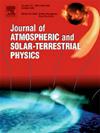Assessment of the impact of WRF microphysical schemes on precipitation forecasting during spring in the Democratic People's Republic of Korea
IF 1.8
4区 地球科学
Q3 GEOCHEMISTRY & GEOPHYSICS
Journal of Atmospheric and Solar-Terrestrial Physics
Pub Date : 2025-01-28
DOI:10.1016/j.jastp.2025.106449
引用次数: 0
Abstract
In this study, the WRF model was used to evaluate the impact of microphysics schemes on the prediction of rainfall during spring in the Democratic People's Republic of Korea (DPRK). The rainfall event was divided into two categories according to the daily accumulative rainfall amount and rainfall distribution: rainfall events with small precipitation(<10 mm/d) and partial coverage of the precipitation area (hereafter SPRE) and rainfall event with relatively large precipitation(≥10 mm/d) and entirely covered area (hereafter LERE), and numerical simulations were carried out for six typical rainfall events (three days for each category) in 2021–2022. The simulation results confirmed that the effects of microphysics schemes differ from each other according to the precipitation event. In the analysis of the simulation results, the accuracy was evaluated using the critical success index (CSI) and false alarm ratio (FAR) indices for SPRE, and MODE analysis was used to assess the agreement with centers of rainfall patterns for LERE. For SPRE, the one-moment bulk microphysics scheme is rather efficient than the more sophisticated two-moment bulk microphysics scheme, and the Ferrier scheme performs best. For LERE, the two-moment bulk microphysics scheme performs better than the one-moment microphysics scheme. In particular, the Thompson and Thompson aerosol-aware schemes have a higher performance than the other schemes. The results of this study suggest that seasonal effective physical process schemes should be selected for operational forecasting, and will help to improve the accuracy of the forecast for spring in the DPRK.
评估WRF微物理方案对朝鲜民主主义人民共和国春季降水预报的影响
本研究利用WRF模式评价了微物理方案对朝鲜春季降水预报的影响。根据日累积降雨量和降雨分布,将降雨事件分为小降水(<10 mm/d)和部分覆盖降水区域(以下简称SPRE)的降雨事件和较大降水(≥10 mm/d)和完全覆盖区域(以下简称LERE)的降雨事件,并对2021-2022年6个典型降雨事件(每类3 d)进行了数值模拟。模拟结果证实,不同的微物理方案对不同降水事件的影响是不同的。在对模拟结果的分析中,利用SPRE的临界成功指数(CSI)和虚警率(FAR)指标对模拟结果的准确性进行了评价,并利用MODE分析对LERE的降水模式中心的一致性进行了评价。对于SPRE,单矩体微物理方案比复杂的双矩体微物理方案效率更高,其中Ferrier方案性能最好。对于LERE,双矩体微物理方案优于单矩体微物理方案。特别是,Thompson和Thompson气溶胶感知方案比其他方案具有更高的性能。研究结果表明,应选择季节性有效的物理过程方案进行业务预报,这将有助于提高朝鲜春季天气预报的准确性。
本文章由计算机程序翻译,如有差异,请以英文原文为准。
求助全文
约1分钟内获得全文
求助全文
来源期刊

Journal of Atmospheric and Solar-Terrestrial Physics
地学-地球化学与地球物理
CiteScore
4.10
自引率
5.30%
发文量
95
审稿时长
6 months
期刊介绍:
The Journal of Atmospheric and Solar-Terrestrial Physics (JASTP) is an international journal concerned with the inter-disciplinary science of the Earth''s atmospheric and space environment, especially the highly varied and highly variable physical phenomena that occur in this natural laboratory and the processes that couple them.
The journal covers the physical processes operating in the troposphere, stratosphere, mesosphere, thermosphere, ionosphere, magnetosphere, the Sun, interplanetary medium, and heliosphere. Phenomena occurring in other "spheres", solar influences on climate, and supporting laboratory measurements are also considered. The journal deals especially with the coupling between the different regions.
Solar flares, coronal mass ejections, and other energetic events on the Sun create interesting and important perturbations in the near-Earth space environment. The physics of such "space weather" is central to the Journal of Atmospheric and Solar-Terrestrial Physics and the journal welcomes papers that lead in the direction of a predictive understanding of the coupled system. Regarding the upper atmosphere, the subjects of aeronomy, geomagnetism and geoelectricity, auroral phenomena, radio wave propagation, and plasma instabilities, are examples within the broad field of solar-terrestrial physics which emphasise the energy exchange between the solar wind, the magnetospheric and ionospheric plasmas, and the neutral gas. In the lower atmosphere, topics covered range from mesoscale to global scale dynamics, to atmospheric electricity, lightning and its effects, and to anthropogenic changes.
 求助内容:
求助内容: 应助结果提醒方式:
应助结果提醒方式:


